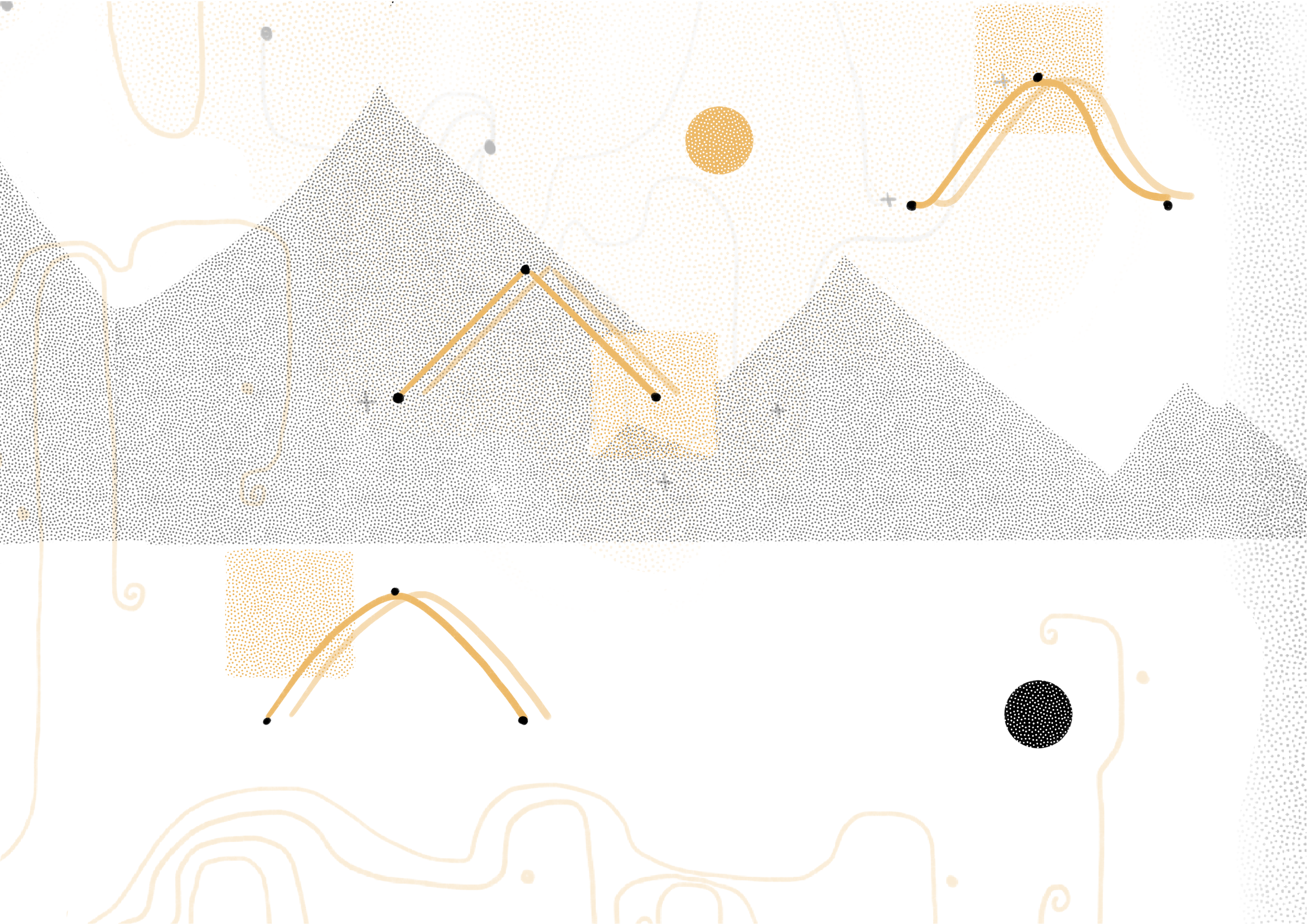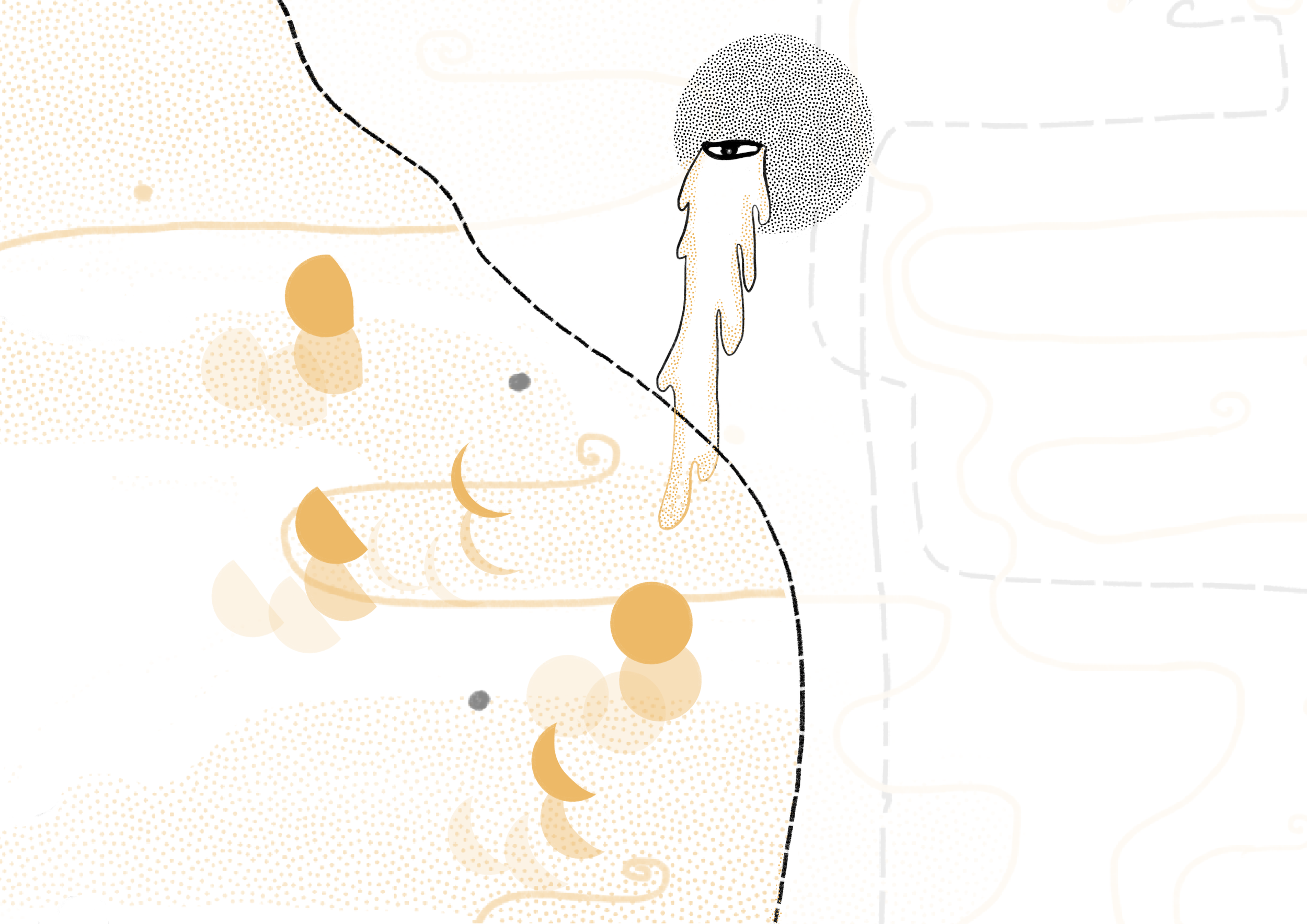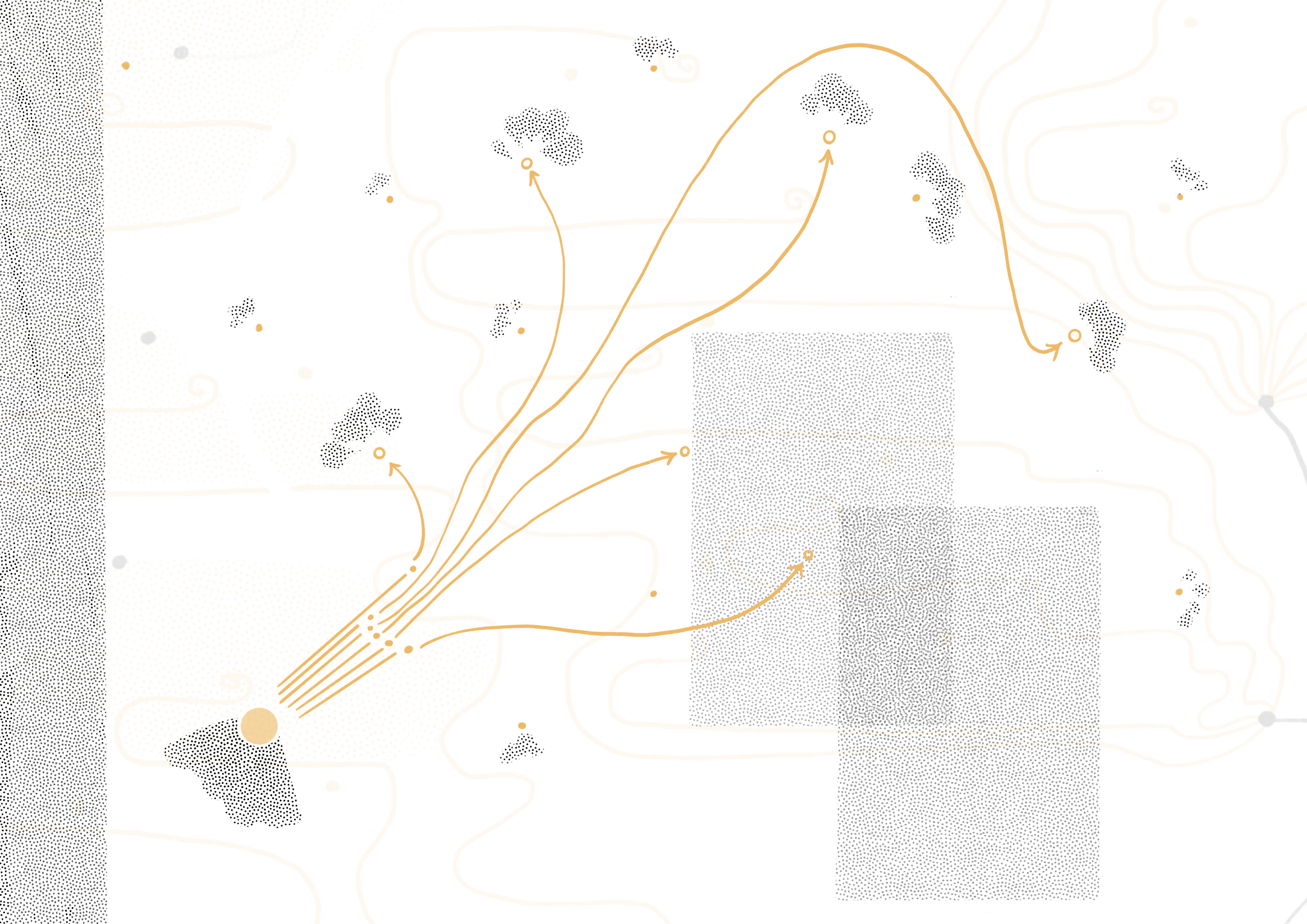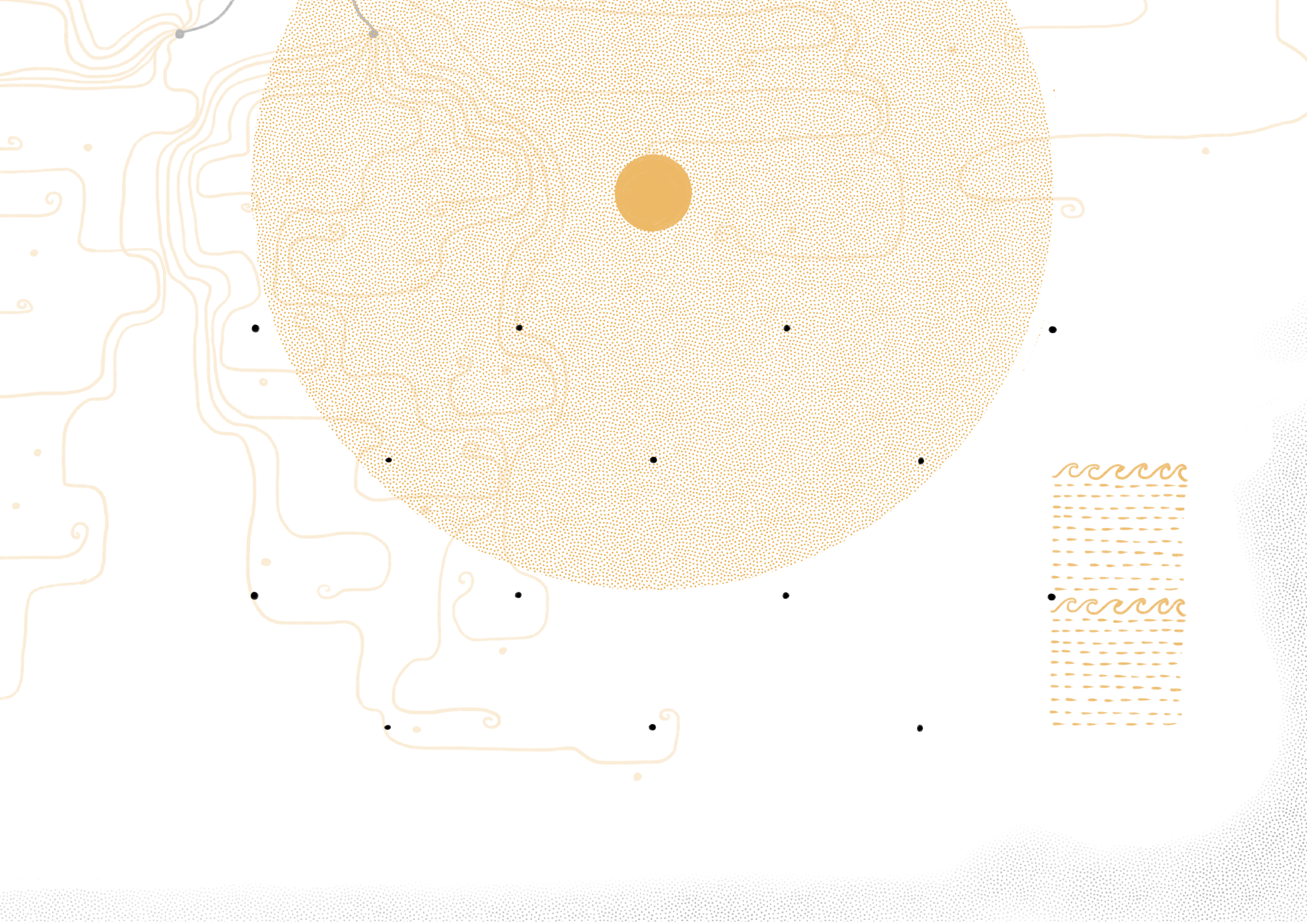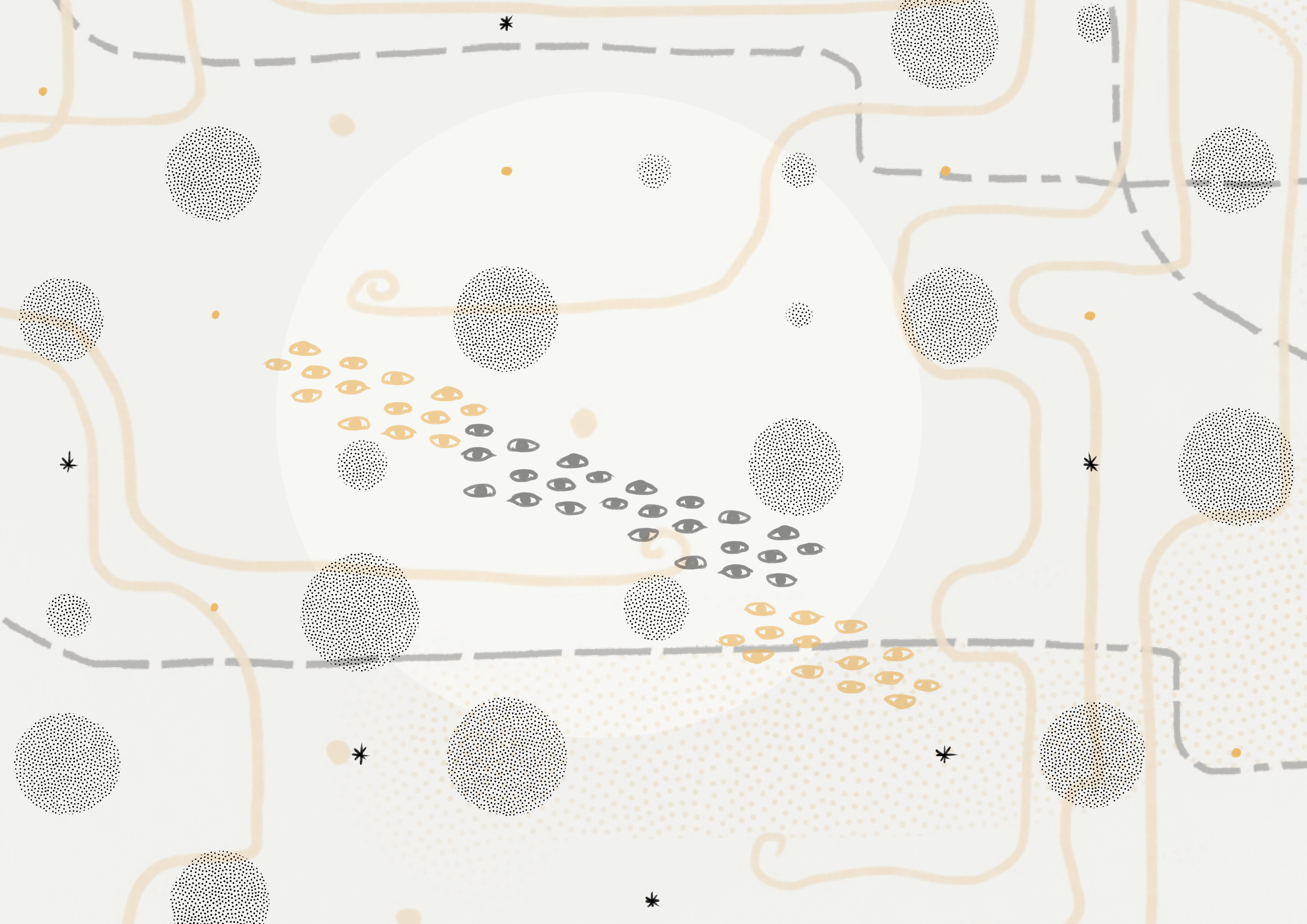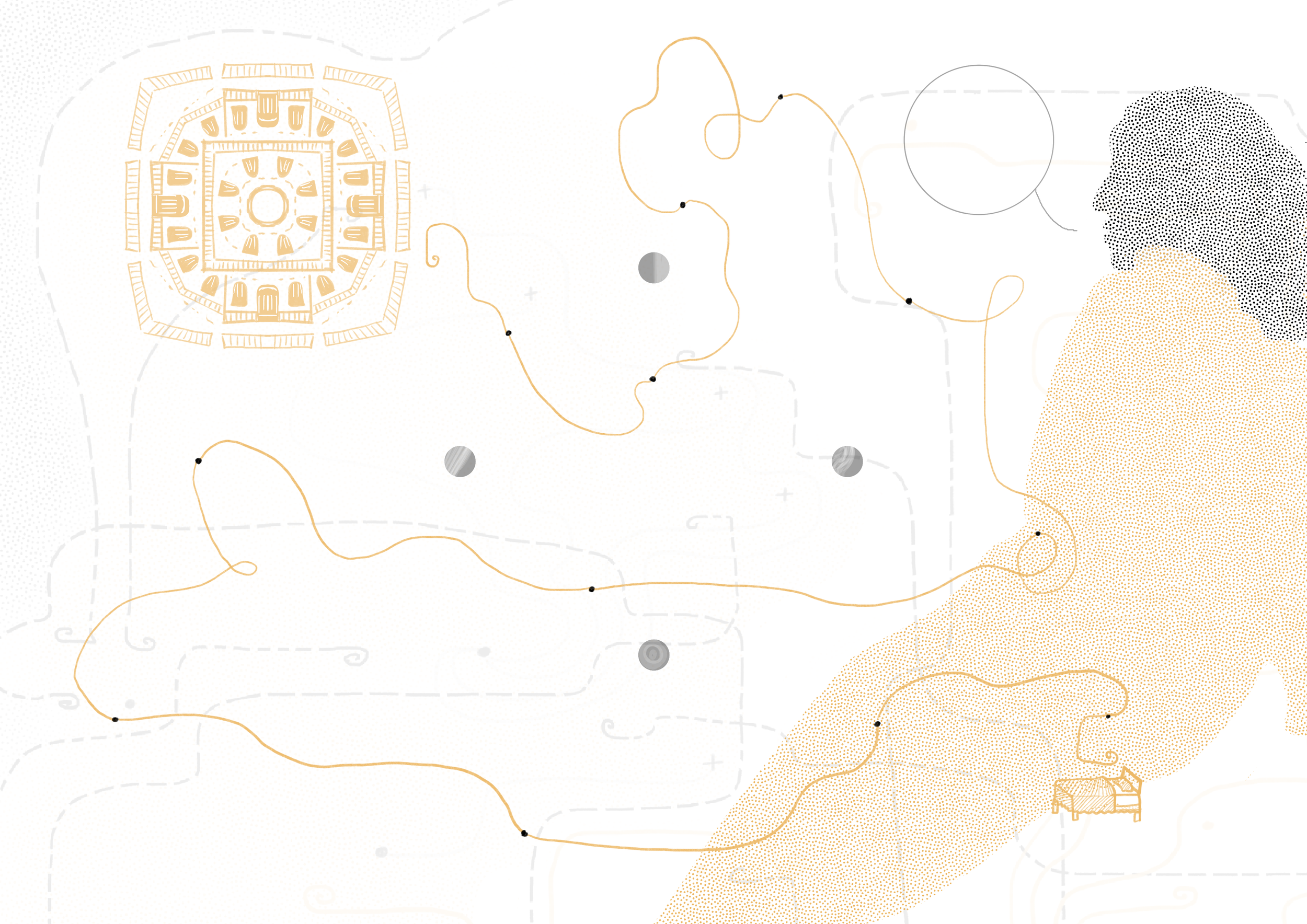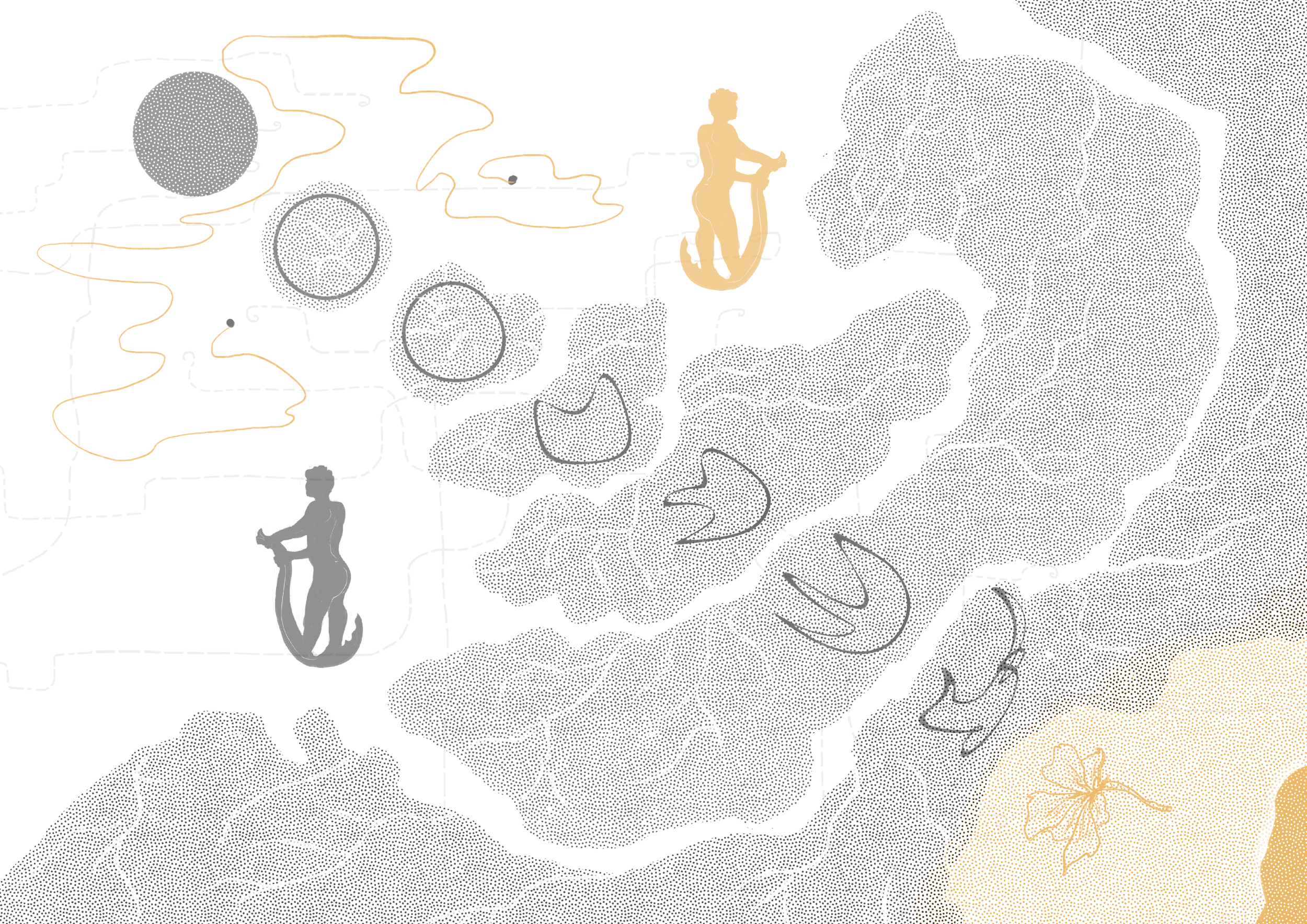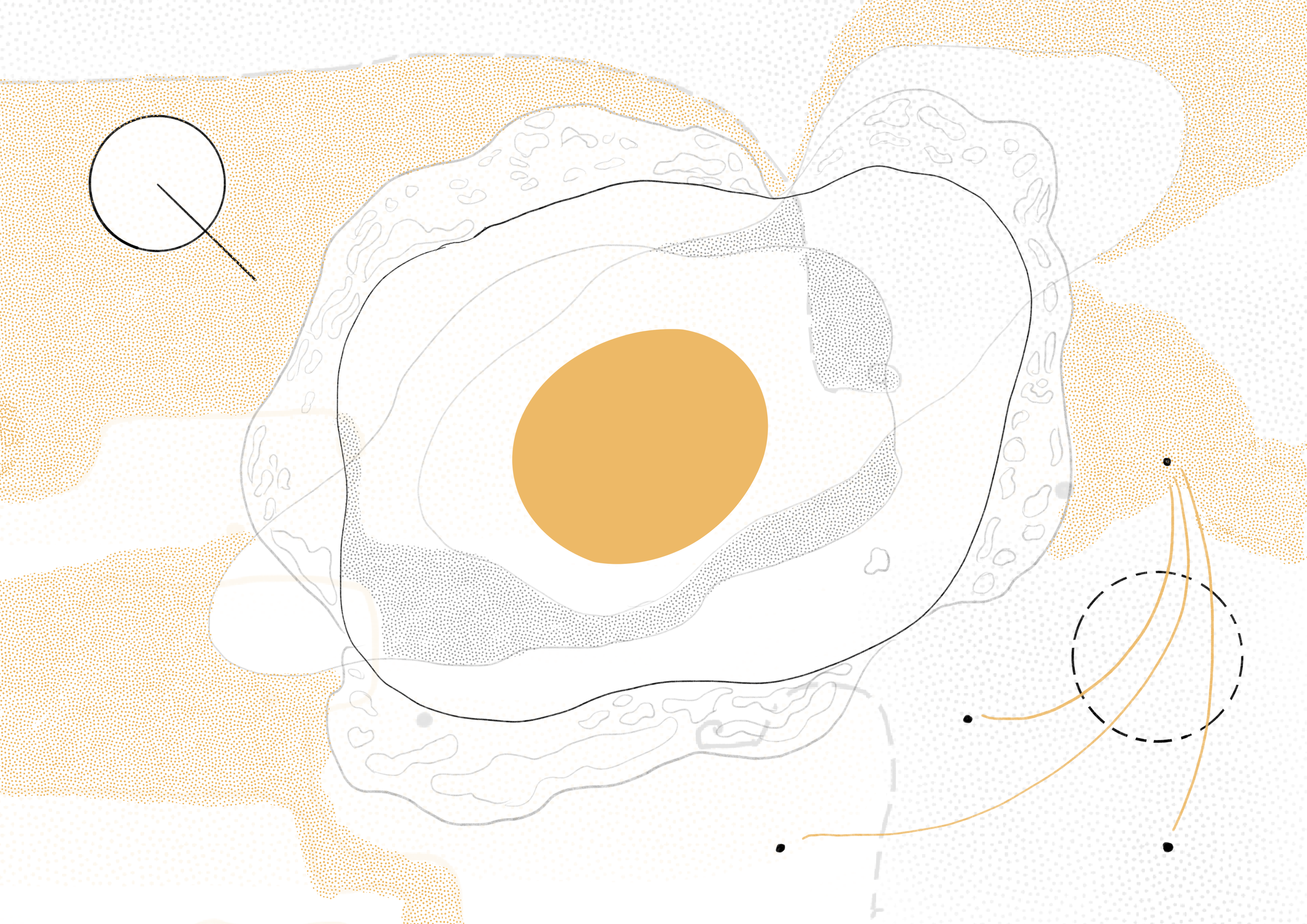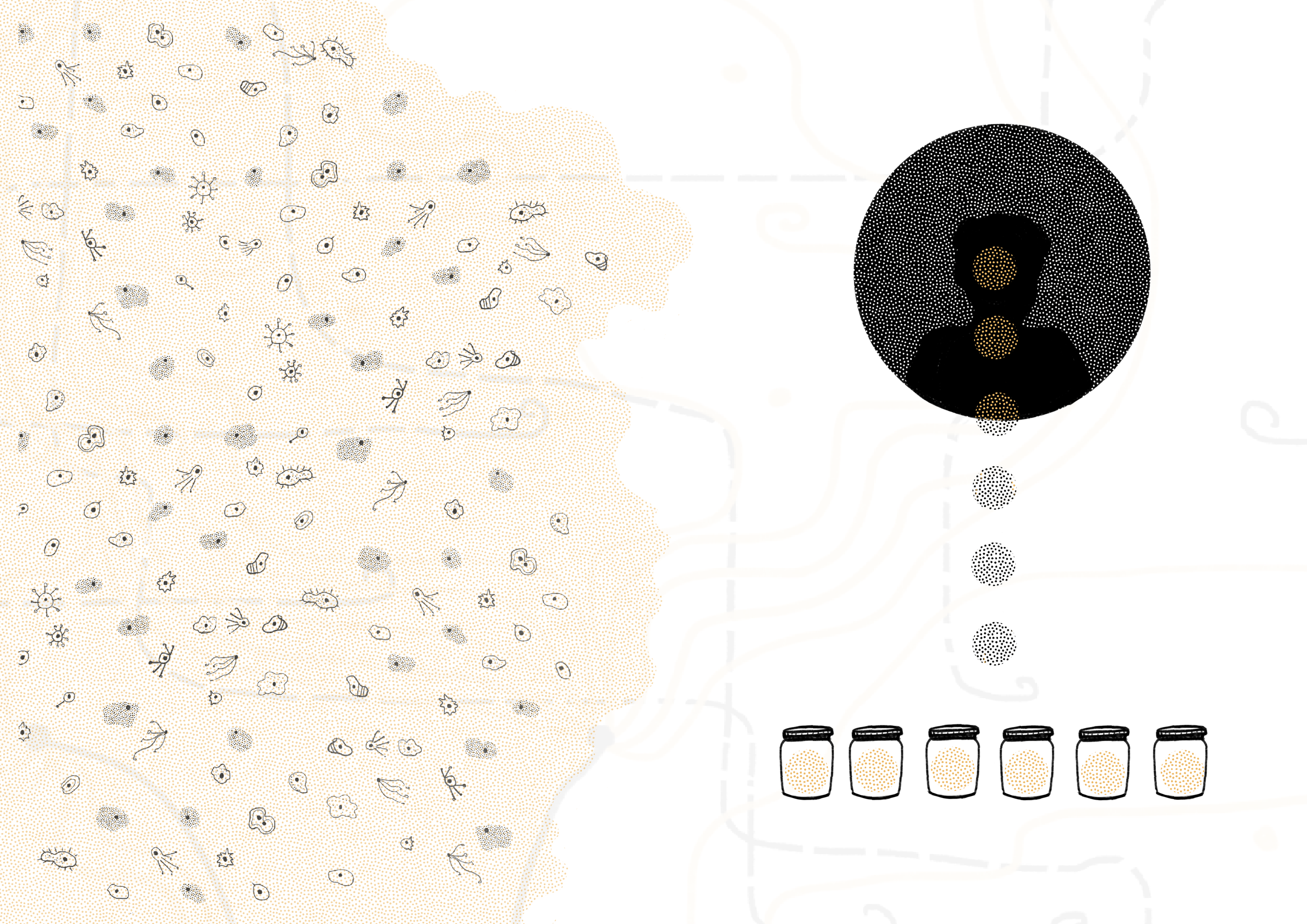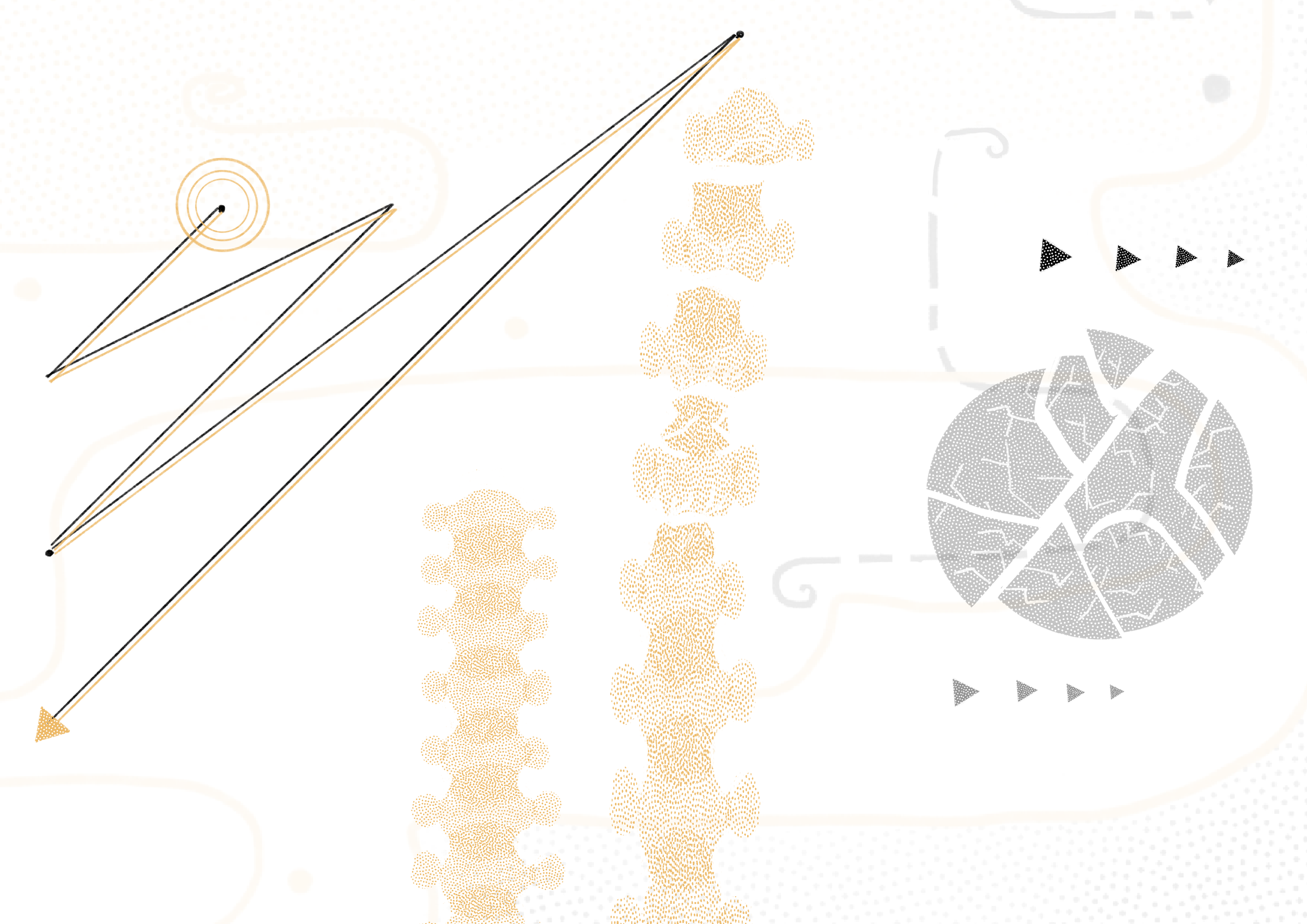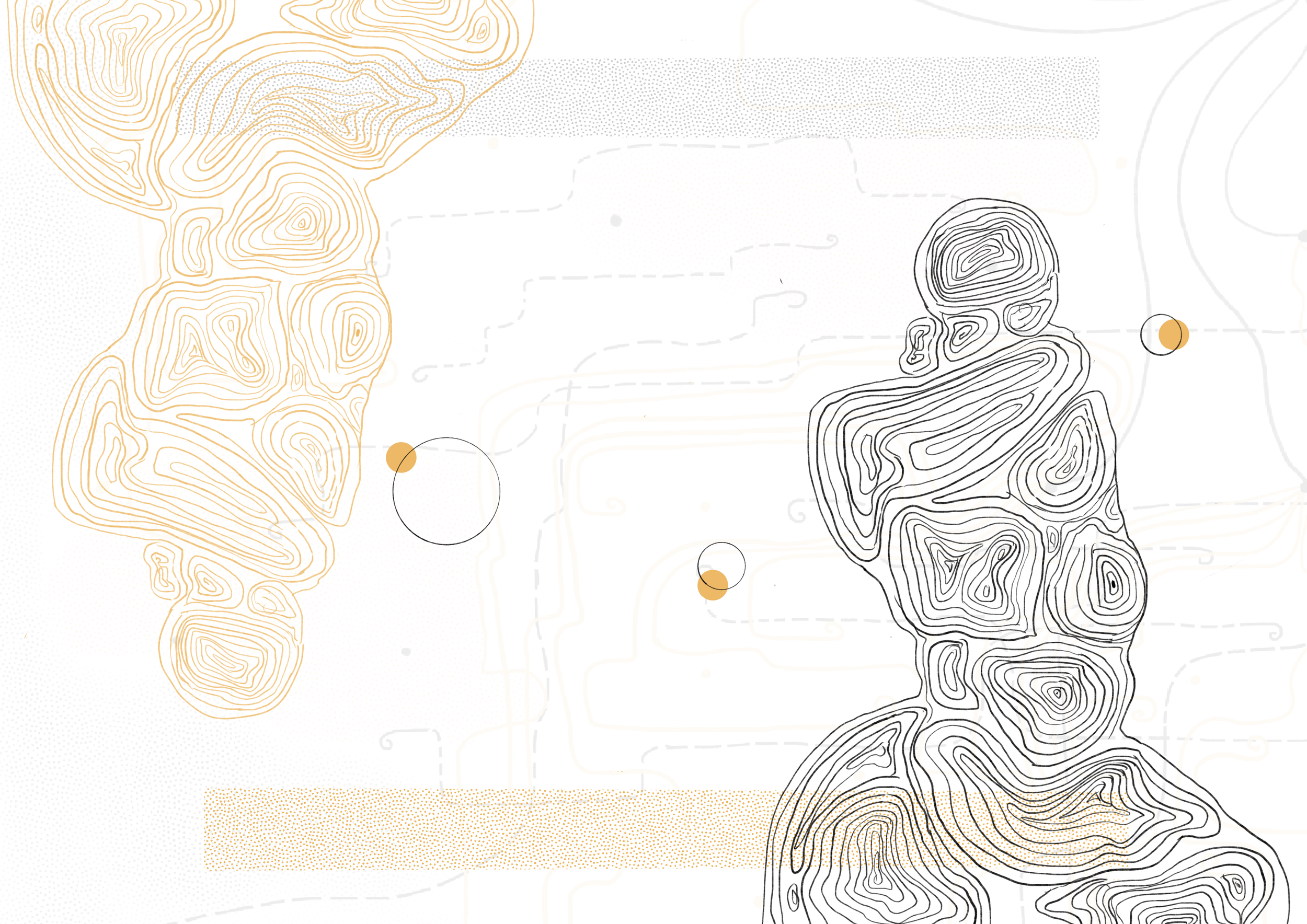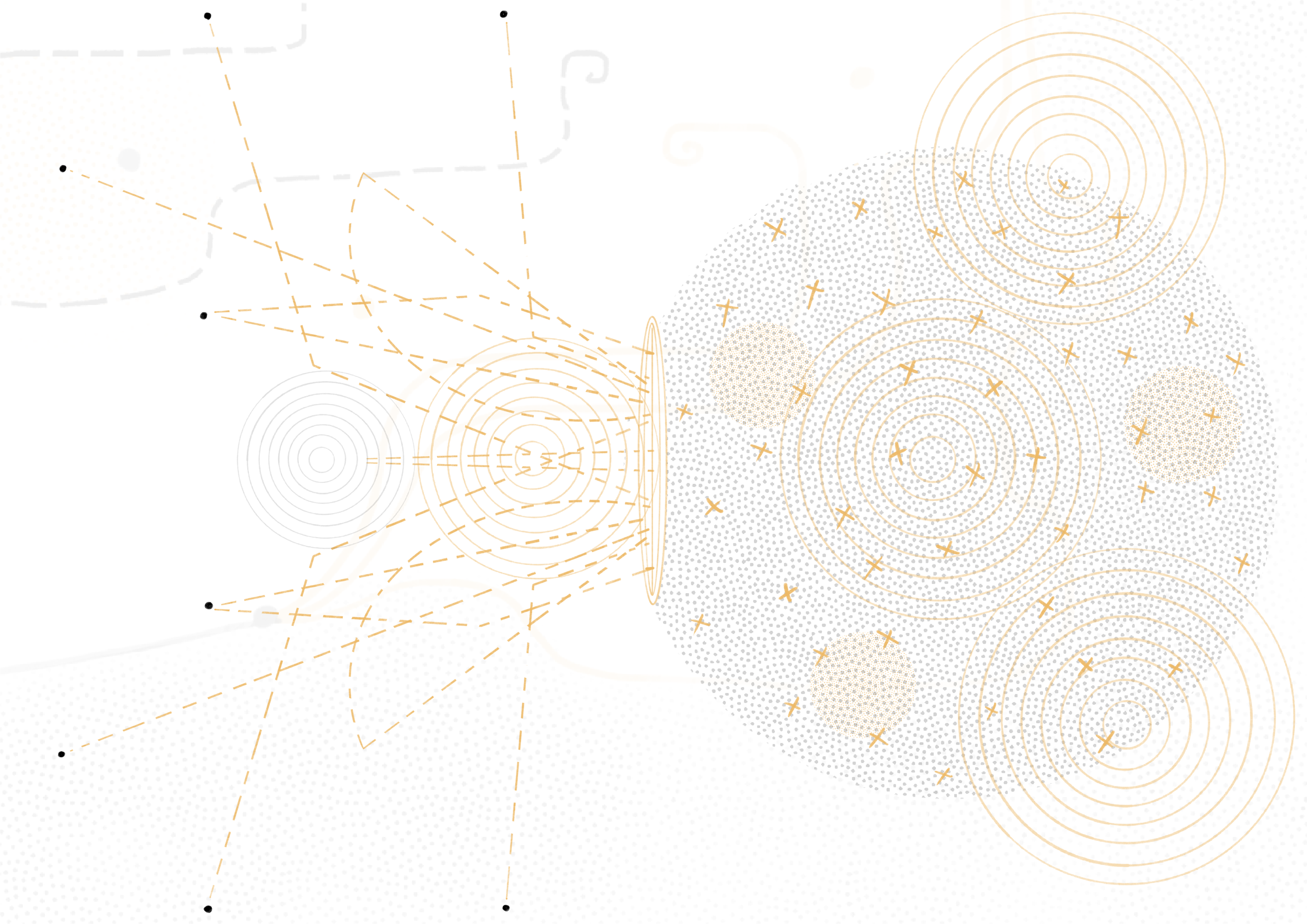The Enduring Grief of Imaginary Lives
Amulya B
PART 1
IMAGINE THIS.
Once upon a time, I fancied myself a God.
A minor deity in a pantheon of Gods.
My duty, I believed, was to carry the grief of Gaia and all her non-human animals within myself. It was an act of giving meaning to the pain I was experiencing – rather than a narcissistic, grandiose exercise of a sick mind. This pain – had no starting or ending point. It would strike the heart like a spear from nowhere. I had to explain this spear, this pain. To myself. Where did it come from. It’s origin.
Some roll the boulder up the hill, and some dedicate themselves to a life of telling stories.
One day, in the middle of a conversation, while carrying a bucket of water, I collapsed on the threshold between the bathroom and the courtyard. The body refuses to be. I do not choose where and when this happens. The body just cries. I do not know whether the crying spell occurs. In a strange city, in my familiar home. In the middle of a party. When I’m just about to pull a jenga block, the floor under me is pulled away.
As my mother rushes towards me, I need to prepare a reason. I need to stitch a story. But I do not have any.
It is called a “crying spell” for a reason. You are under the “spell” of something that is physiological. Yet its beginning seems otherworldly. After all, in Hindu mythology, all water is Gange and Gange descended from the heavens. So, it isn’t a surprise that there is no earthly trigger for my tears. If there is a trigger, it is lost in the world of electric pulses and double helixes – a world as strange as the heavens, if not stranger.
Like Gange who is embodied with the power to purify, I had read somewhere that crying releases feel-good hormones like oxytocin and endorphins. That means, with tears, the pain should also go away. But, when you are the deity chosen to experience pain in others' stead, you continue to hurt. You do not feel good. The pain stays.
Since every act of purification implies loss, if nothing was lost, there was no purification.
Soon, you realise the reason has breached the walls of your tower of imagination. You are no longer a deity. Yet, the pain stays. It comes in waves, in unsteady intervals. You learn to navigate around it - with some external help. You find your pole star. In the rough seas, you will need it.
I was told, grief is an emotion that follows loss. Only through the acknowledgement of that loss can you grieve.
That’s when it hits me, I am grieving without knowing what I have lost. Can you lose something that you never had?
2.
When I received the call, I’m in Harapanahalli. This town which was part of Davanagere district until a few months ago, is now part of the newly formed Vijayanagara district. The hand-painted boards of the shops, however, still live in the past. So do some of the people. I resist the urge to ask the town itself, where do you belong?
It is neither afternoon, nor evening. I remember the oblong rays of sun, warming my head and my shoulders. Holding a heavy camera mounted on a gimbal, my colleague slowly moves towards the group of women sitting cross-legged in the courtyard of the local school. And away from me. That’s when I feel the vibration in the pockets of my jeans. The call was expected, but not the news.
I hear my mother on the other end. I hear the words.
I hear my Chikkappa is dead.
I’m in the middle of a story shoot. I tell my colleague the news. He tells me to leave. Go to Hospet and catch a bus to Hubballi. By the time I arrive in Siddapura, the ambulance would have arrived from Mangaluru too. I’m closing and reopening Google maps. Tracing and retracing the route. Should I go to Davanagere instead of Hospete, which is in the opposite direction?
As I stand paralysed like a doe in front of headlights, the ambulance is already on the green corridor with no traffic lights on its path. I can hear my mother’s words “You don’t worry. I’m not alone. He is right next to me.”
She utters his name, almost in a whisper. As if he would wake up if you speak loudly.
3.
When I was no older than 10, I was part of a children’s theatre production. It was a play about two characters who enter each other’s worlds. The girl belongs to the world as we know, while the boy belongs to a world of “human dolls” who only come alive at night. As soon as the sunlight hits them, they freeze. They are no different than a stone. They are essentially non-living things, with no consciousness. When they freeze, they no longer exist in the world of the living, nor they are completely dead. They exist in a liminal space, much like a virus.
Writer and journalist Joan Didion did not like grey areas concerning life and death. Writing about her niece, who is in ICU fighting for her life, she writes:
“She could not keep herself unaided but she was alive. That was white. When they turned off the life support, there would be a matter of minutes before her system would shut down and then she would be dead. That was black”.
When I’m on a stage, I’m white. There is a script. My body makes the space its own. When I’m off stage, there is no script. I’m numb.
I’m grey, wishing to be white. I’m grey, wishing to be black.
4.
It was black when the family decided to switch off the ventilator. He was able to defeat mighty cancer, but puny pneumonia had won. I hear the doctor did not accept the fee owed to him; he felt so defeated for failing to save my Chikkappa. Despite the good prognosis. Isn’t colon cancer, one of the better cancers? As if there’s mercy in malaise.
I hear, he did not want to fight. He had already given up. He was tired. With each passing day, the cost of treatment was piling up. You do not talk about money in front of the already demoralised patient. But people do. Sometimes people forget that under all those tubes, machines and bandages, there is a human being. He is still alive. But when you are sick, all that people see is a body. It is already black for them.
When you see yourself as a burden on the family, and on the world, you too would want to give up. This is a familiar feeling. I know that better than anyone.
I do not know whether I would have been able to change anything if I had been there. The reality was I hadn’t visited him in nearly a decade. I don’t even know who’s who in the ever-expanding family tree. Is ‘I was trying to save myself’, a good excuse? Yet, I imagine. I imagine a positive outcome. After all, it is always an outsider who changes the course of the story. It is an outsider, who becomes the saviour. In stories, the Chosen One is always an outsider.
But I was not an outsider in the family. Not more than my mother. She was the ultimate outsider. A Shudra in a Brahmin household. If anyone could have changed the story, it was her.
When I stood paralysed in a faraway place, my mother fought for him.
It was still white for her.
I never did arrive to see my Chikkappa off.
I continued to be in the grey.
5.
For writer Han Kang, the colour of grief is white. In her The White Book she talks about her older sister, who died within two hours of being born. Kang never met her. Yet, she associates her with the colour white. She had a “face as white as crescent-moon shaped rice cake” – so her mother says.
So, when she decides to write about her sister, she chooses several white objects. Using those objects, she weaves an imagined life for her sister:
“And I think of her coming here instead of me.
To this curiously familiar city, whose death and life
resemble her own”
Kang’s imagined life for her sister operates on a principle of Either/Or. There is no universe in which both of them could be alive. Same as me and Chikkappa. I never imagined that I would ever live beyond 30. Now that I have crossed that threshold, it seems like a new life granted to me. But, maybe I had a price to pay for this. Maybe I was not meant to survive. But I did, so someone else had to take my place.
Either/Or.
One of the earliest memories I have of him is him crying. Crying in a doctor’s office in Bengaluru. Begging the doctor to save his son, my little brother - a blue baby. This is the only memory that is coloured by blue. This is the only moment that stands separately. When a memory is not acknowledged repeatedly, does it cease to exist? Can a memory, ever just exist without any influence of the present? Should it always mutate, when new knowledge presents itself?
Kang says No. In a section called Sugar Cubes, she writes: “there are certain memories that remain inviolate to the ravages of time. And to those of suffering. It is not true that everything is coloured by time and suffering. It is not true that they bring everything to ruin.”
There are many memories that I hold dear, which are uninfluenced by the current status of the individuals in them. In one such memory, my Chikkappa smirks and looks at me, not through the glasses, but just above the rim. My insult humour is barely touching him, sliding off his shoulders like a dewdrop on a waterproof jacket.
I remember him on the red and cream coloured scooter taking me through the town of Siddapura. I remember him returning with a packet of sanitary pads, even though every woman in the household still uses cloth. All because his niece had asked him to buy it. When I went back to Bangalore, I had to hear a lot from my mother. I do not remember whether it is for asking for something that should be a secret or something that was expensive for a stringer and a lawyer with an uncertain income.
No one ever did buy me something like that again.
If you ask me what the colour of grief at this moment is, it is yellow. It is yellow like the ice cream that would come in the mango-shaped container, which my Chikkappa had to buy four of because he did not discriminate against children. Even though the cousin had returned home next door, he would still get one.
It is yellow that was and is the colour of his room. When sunlight passes through a plastic sheet and a yellow cloth, the room is awash in the colour of grief. On the 12th day, I slept there. On the same bed away from the people and the rituals. I do not know whether it was the overnight journey, the slow creeping of an oncoming dark episode or just simple grief, I slept. I woke up with dried tears on my face and most rituals having concluded. I hope he was not offended.
In the evening, we go to the place where his body was cremated. The canopy is dark green, the soil is brown, and the grass on the hill ahead is yellow. The same hill where we all went on evening walks to eat wild berries. It was there he was let go. In the intersection of three roads, where the said hill overlooks, we light an earthen lamp. The flame flickers in the wind for a moment, before settling. I’m asked to turn away from the flame and walk away.
‘Do not turn around’, someone says. It was for me. We slowly walk with our backs to the flame hoping that his soul has now joined the flame to move on to the afterlife.
The same night I leave for Bangalore. I remember the countless return journeys with fireflies lighting the dark forest streets and twinkling stars above.
Yellow dots. White dots.
Now, all black. No stars, no fireflies.
Cutting through the darkness are the cones of light ahead of me from the auto rickshaw.
*******
PART- 2
HOW MANY SYLLABLES DOES GRIEF HAVE?
1.
One of the first things you learn in Kannada grammar is to “put laghu, guru”. It is a method of counting syllables by marking either U or — above the words. Unlike English, which recognises only the presence of vowels while counting syllables, in Kannada, you also need to consider the time. The time it takes to utter that vowel. The time it takes to let the air escape from your mouth.
The shorter vowels are marked with U and longer vowels with a __. U is counted as one and __ counted as two.
The word “grief” is a monosyllabic word in English. When I bring the same word to Kannada, without translating, I will have to mark the ‘e’ sound with a __ symbol, since it makes a longer vowel sound.
In other words, the same word becomes a two-syllable word.
When I grieve in Kannada, I’m surrounded by my family.
When I grieve in English, I grieve alone.
I cannot find words in Kannada when I talk about my body and the ailments it suffers from. The way it moves in the world. Its limitations.
I grieve alone when I talk about this body and its lost potentialities
I grieve alone when I think about the lives it could have led.
I grieve alone when I think about the happiness my body could have had.
2.
While talking about her body in No Straight Thing was Ever Made, a collection of mental health essays, poet and writer Urvashi Bahuguna, never uses a possessive pronoun: it’s never my body. But, the body. She distances herself from the body. It is a natural response when you locate the root cause of all your anxieties in the body.
One way to achieve this distance is by making the language unfamiliar – like Bahuguna. The other way is to completely let go off the language, which does not provide you the said distance. There is a reason I’m writing this essay in English. Even though I’m fluent in Kannada, I cannot intellectualise in the language. When I’m in the bhaavajagattu (emotional world) of Kannada, I’m significantly rawer and easily swayed by emotions. My intellect is dormant.
In Kannada, I’m naked. I’m translucent. You can see my organs doing what they do: beating, expanding, contracting.
In English, you only see what I present to you. I can hide in the third person references, in the grieving of others, using them as a jumping board to talk about mine.
You will know me, but not really. I’m in control.
I dress up my body in English. In English, I feel safe.
But what do I do at nightfall? When the silence slowly creeps into every crevice of the living space, like the cold air? When everything stops and nothing moves?
In the nocturnal silences, language ceases to exist. Communication is taken over by something much more primal. Either there are sounds – retching, cries inundated with hiccups…
…Or nothing.
3.
When Chimamanda Ngozi Adichie says grief “is not gauzy; it is substantial, oppressive, a thing opaque,” she is commenting on the materiality of an emotion that is difficult to capture. “The weight is heaviest in the mornings, post-sleep: a leaden heart, a stubborn reality that refuses to budge.” Perhaps due to its weight, people expect you to not carry it further than what is usually considered the norm. If you do, you move into the realm of pathological grieving.
By default, I am a pathological griever. The sinking feeling that Adichie observes is eerily familiar. Some days, when I get up in the morning, the first thing my eyes lay on is this feeling, externalised: like a pet, it begs for attention. I sigh. So, this is one of those days, then. Before I know it, I’m heavier than I have ever been. My legs are dragging, my back is bent. It looks like, I never did keep my overweight school bag away. I carried it to my bed. Each part of my body is made of metal. All the characteristics that you have come to associate with organic life are suspended. All biological life processes are halted temporarily or in a battery-saving mode.
Maybe this is the aftermath of the grief for many people, that strikes unexpected. There is often an object, whose loss triggers grief. But for me, it is an anticipated certainty with no trigger. If not today, it will come tomorrow. So, what happens when grief of loss strikes an already grieving body?
It unravels.
4.
For Joan Didion grief and mourning are separate things. “Grief was passive. Grief happened. Mourning, the act of dealing with, required attention”. But attention is a curious thing. My body does not know how to regulate it. The same goes for memory, sleep and emotions. The all or nothing way of living quickly exhausts you. Either you are too fixated on the way you are grieving, carefully monitoring yourself, or you just abandon everything, letting your body and mind collude to take you on a self-destructive path. There is no in-between. So, it is easy to deal with the passiveness of grieving over the regulatory mechanism of mourning.
Grief rarely becomes mourning, especially, for those of us who witness our own deaths, every day. In different ways. You realise you do not have the energy to do the things you used to do. Your memory is no longer reliable. You confuse dreams with reality. Your brain changes, becomes something else with every stressful activity. Ironically, you refuse to take medicine because it may “change you”. But, friend, you are already no longer you.
This was me, once upon a time when like many, I believed that medicine is something that I did not need, not because it would help me, but because I was beyond help. There was also an irrational fear of losing my edge, and my creativity. But more than that, I felt my pain was more existential than a symptom of an illness. Writer and Professor of Psychiatry Kay Redfield Jamison perfectly identifies this in her memoir, An Unquiet Mind:
“Somehow, like so many people get depressed, we felt our depressions were more complicated and existentially based than they actually were. Antidepressants might be indicated for psychiatric patients, for those of weaker stock, but not for us.”
This association of taking medicine with weakness is way too common. Much like Jamison, self-reliance is a virtue I hold dear. I tell people proudly how I travelled across the city by myself to theatre classes, when I was no older than 10. I was navigating the real world way sooner than my peers.
When I was first prescribed anti-depressants and mood stabilisers, I cried for days before taking that first pill. I felt I had failed myself in resisting whatever that was taking over me. It took me some time to arrive at that ideal combination of medication. Medication and therapy help you turn your grief into mourning.
The fear of losing oneself is real. But, without help, that fear will become a reality. I don’t think I’m the same person I was before medical intervention. But I’m alive. Isn’t that something?
5.
When I first saw Tracy Emin’s My Bed (1999) at Tate Modern few years ago, I was struck by its pedestrian aura. Unlike the contemporary art I had seen till then, it did not expect me to intellectualise. It aimed at being affective, and through that affect, effective. Effective at eliciting the pain and the aftermath of grief.
Is there a witness for grief truer than that bed of yours?
6.
You are put together, but it is visible. It is not a usual black dog, but a black elephant that is too huge to fit into the office, let alone in the bathrooms that were built before I was born. When you bring an elephant, of course, people will notice. It has never happened before because I never did know the elephant existed. I’m used to the dog. The highs and lows it brings. But, what do you do with the elephant in the room? Do you talk about it?
Apparently, she noticed. What is happening? Why are you under the shadow of the elephant? I say I’m trying, I’m trying. But it doesn’t go away. I cry at night, and become numb in the morning. I dream of him, I become numb in the morning. I finish a concealer every two weeks. The wounds on my heels and feet continue to bleed. I drink after months only to immediately regret it. I stop taking my medications. I rage at myself for not shouting at them when they bring their friends to the wake of my Chikkappa, as if it is a celebratory occasion.
Then, silence.
The body wants to hibernate. Like the double depression, double grief is exhausting, I presume. The body wants to rest. The body wants to be at rest. Once, the body found happiness on stage. It moved, it danced, it shouted, it expressed all the emotions that it had on stage. Sensitivity to your own body, to the society, to your fellow actor was welcoming. It is easy, when you are given a script. When the dog is assumed to be part of the act.
All eyes are on you. Instead of indifference, you see admiration.
Is there a better way to hide than in characters and their stories?
7.
In moments when it becomes unbearable — I’m on the floor trying to soothe myself by patting, caressing, swinging back and forth but failing – I think of faith. What it would be like to have an unflinching belief in a power that is omnipotent. Would I be… not happy…but free from all the pain?
I think of faith. What it would be like to rely on an overpowering entity. The silver Ganesha which Chikkappa gave to my mother, now sits on a tile slab next to the kitchen sink. A Buddha is in thought next to him. Both of them are connected through a cobweb, with a spider hanging in between. No matter which god the pilgrims of the insect world worship to, they need to fight their nemesis before the darshana.
I have never thought of clearing them, because it does not seem to bother me like many people. Even if I had faith, I don’t think I would. But after he is gone, I want the webs gone too. I haven’t got around to it yet. Once every few days, when I remember its existence, I check up on the silver Ganesha. Even though the chance of it vanishing into thin air is nil. But I still do. I lose things very easily. After learning the possible reason for my forgetfulness, time blindness, clumsiness, executive dysfunction, it has been much easier. But what is lost, often stays lost. The intervention must happen prior to the loss. That’s how you learn to trust yourself.
But sometimes, loss occurs before you even had any control over it.
I do not remember how young I was when I lost the Saligrama from the Gandaki nadi that my grandfather gave me. I think my faith was lost with it and I have carried the guilt of it since then.
So, when Didion asks, if faith and grief are the same, I’m struck by it.
ANSWER 1:
No, they are not. Grief is often a response to loss. It is a net negative value. But faith is not a response to anything. Faith just exists, with or without a God to which it is directed. Faith is a gain, a net positive. How are they the same?
ANSWER 2:
Yes, they are. When looked through the lens of Judeo-Christian thought, every single human being is a sinner due to the original sin of Adam and Eve. All the sinners grieve for this paradise lost. Only on this grief, is the Christian faith is built. How are they not same?
Whatever may be the answer, I realise one thing: grief is no lone traveller. There is always something else with it. Often, it is guilt. Other times, it is love. On occasion, even happiness. Whomever it decides to bring along, the weight only increases.
And it lasts. Until you unknot them.
Until grief becomes mourning.
8.
In the beginning of what can be called ‘a collaborative essay’ between the American writer Vauhini Vara and an Artificial Intelligence (AI) called GPT-3, she admits, she has always avoided writing about her older sister. She was diagnosed with a rare cancer and passed when they were both in high school. There’s no rule that all writers have to deal with grief through writing, not all artists have to deal with grief through art.
But most, not only do. But are expected to do. If not by society, then by their therapists.
In Ghosts, that’s what Vara does, but with a lot of help from the AI. What results are 9 stories about her sister, which begin from a place of truth. When Vara feeds few lines, the AI takes over from where she stops. More information about her sister divulges in, more she receives from the AI. The stories are beautiful and if I hadn’t told you, you wouldn’t know it was written by an AI.
In a way, the AI was not only completing her sentences literally but was constructing alternate realities not only for her sister (“her dark eyes, her long thin fingers. But these are just the details that are universal to all sisters”) but for Vara (“I remember that, on that walk up the beach, she stopped to take off her shoes and socks”). None of these things are real. A physical description with no knowledge of the sister is being given. A memory that did not happen is introduced here.
When I first read this “essay”, I was equally sad and horrified. What if I did the same with GPT-3? Would it give me a chronological story of my Chikkappa, at the same time free me of this grief? In other words, would it help me deal with this grief to turn it into mourning?
This translation of grief into mourning can be best seen in Zoe Leonard’s Strange Fruit (For David) (1992-97). The art work is dedicated to friend and fellow artist David Wojnarowicz, who passed away at the height of the AIDS epidemic in the US at 37. Over 295 oranges, bananas and other varieties of fruit are eaten and their torn skins are dried and stitched back together with different coloured threads while also embellishing with objects like zippers, buttons, wire and so on. These newly-made objects are kept on the gallery floor, in no particular fashion “where they continue on their implacable business of rotting or shrinking or mouldering away, until in time they will turn to dust and vanish altogether”, writes art critic Olivia Laing.
The art may be a comment on mortality or on the nature of grief itself. The impermanence of it all. When I first learnt about this, I thought of zombies: the American cultural phenomenon. You may have heard how certain medications for mental illness can zombify you. The fear is real and all encompassing. Though someone once said my extreme sensitivity to the external world shouldn’t be pathologised, I’m glad I made the decision I did.
I sometimes see myself as a zombie, a zombie compared to my previous self, running into the walls of Kubler-Ross model – my own personal labyrinth, my Chakravyuha.
Zombie or not, I have repeatedly stitched myself together in secret and presented my best self to the world. Everyone rots away in their own way. Only some of us are (un)fortunate enough to be acutely aware of it.
When poet Ocean Vuong says, “grief is perhaps the last and final translation of love”, I want to believe him. He says it is the last act of loving someone and it will never end. But, does it have to be this painful and all-consuming?
Can I do this till the end of my life?
This act of translation of grief into love?
*******
Amulya B is a Bengaluru-based writer, translator and multimedia journalist. She works in both Kannada and English languages. She is the winner of Barbra Naidu Award for Personal Essay (2018), Toto Funds the Arts (TFA) award for English and Kannada Creative Writing (2021).
